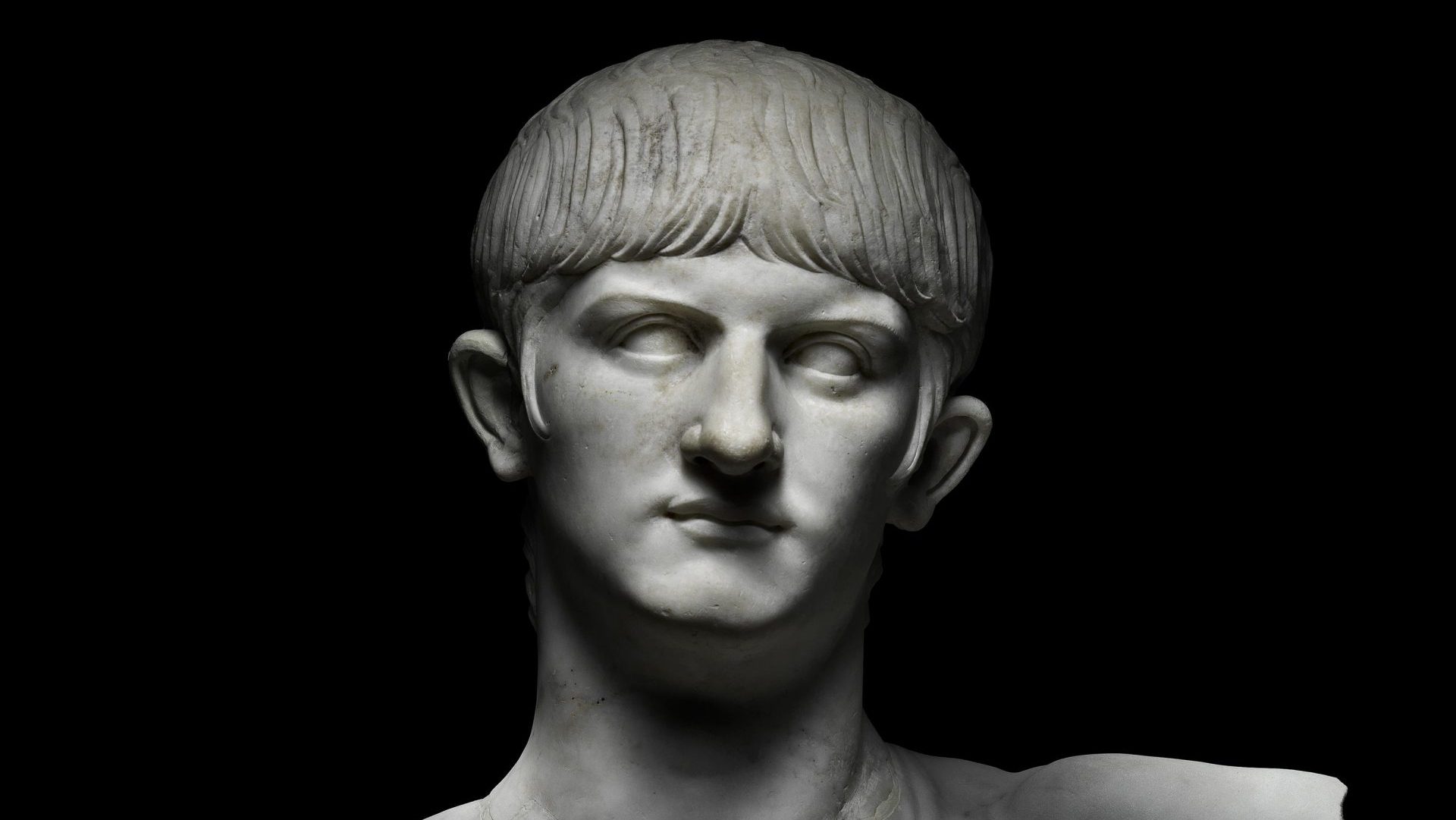Perhaps it was simply that Nero was born under a bad sign. According to the Roman historian Suetonius, at his birth “direful predictions were made from his horoscope”. Even the emperor’s father remarked darkly that “nothing that was not abominable and a public bane could be born of Agrippina and himself.”
Today, Nero is remembered as one of history’s greatest villains, a murderous sexual deviant who “fiddled while Rome burned”, indulging his need for public approval by participating in unseemly public performances including chariot races and plays, and embarking on lavish building projects, while neglecting the business of governing an increasingly unstable empire.
Nero’s reputation was sealed in his own lifetime, which ended with his forced suicide in AD68. Early accounts offer clues to a more complex story, the reports of “fake Neros” that cropped up for decades after his death suggesting the extent of his ongoing popularity.
Just as today’s politics is riven with spin and misinformation, the British Museum’s exhibition Nero: The Man Behind the Myth sets out to show that this much-maligned figure was the victim of a concerted campaign to discredit him.
Hartwig Fischer, the director of the British Museum, makes explicit parallels with today’s politics, writing that the commonly held view of Nero “resonates with our times: a world with deepening social and economic challenges, in which fake news, contested facts and the polarisation of opinion amid political machinations are commonplace.” His words take on new significance following the recent appointment of former chancellor George Osbourne – author of devastating cuts to the cultural sector – as the museum’s new chair.
More than 200 objects including coins, fragments of paintings and buildings, jewellery and statuary, paint a more complex picture of Nero, who is presented as a pragmatist more than a tyrant. In doing so, it offers a fascinating insight into the means by which Nero’s image was controlled and manipulated, by both his supporters and his enemies.
The most famous image of Nero is the sculpted marble head that opens the show. It is a hard, unyielding face, the lips curled into something like a sneer, the set of the jaw, the angle of the head, and the shape of the chin suggesting an arrogance and cruelty that accords with written accounts.
The head, which normally resides in the Capitoline Museum, Rome, dates from the emperor’s lifetime, but is in fact made up in large part from a much later 17th century restoration. A close look reveals that it is not a single entity, but consists of a small, ancient fragment, set into a much larger, later one.
The forehead, eyes and nose are contained within the oldest fragment, but the entire lower part of the face was made much later, based, it seems, on the less than complimentary evidence of Suetonius, Tacitus and Cassius Dio, all of whom were writing some time after Nero’s death.
In fact, even the ancient fragment cannot be relied upon, as it was repurposed as a portrait of a later emperor sometime after Nero’s death.
Other, less familiar portraits of Nero were made at different points in his reign. The earliest dates from AD 50-54, and shows Nero as a young prince of around 12 or 13 years old, wearing the locket (bulla) associated with boys not yet come of age. The statue was probably made to mark Nero’s adoption by the emperor Claudius in AD50, who had married Nero’s mother Agrippina the previous year following the death of her husband, Nero’s father.
Though Claudius had a son of his own, Britannicus, he made Nero crown prince in AD51, three years before he became emperor shortly before his 17th birthday. Claudius’s decision to favour Nero over his own flesh and blood is often seen as early evidence of Nero’s manipulative character, aided by his mother who schemed and plotted in the background, like a Lady Macbeth of the ancient world.
The truth is more prosaic: the Julio-Claudian dynasty, which supplied the empire with its first five emperors, beginning with Augustus, had always depended on adoptions to ensure a male heir. Claudius’s own son, Britannicus, was too young to be his immediate successor, and Claudius himself had never been acknowledged as a member of the Julian dynasty, making him vulnerable to coup attempts.
Nero’s bloodline was Claudius’s lifeline: through his mother Agrippina, Nero was related to both the Julian and Claudian lines, and by marrying his mother and adopting him, Claudius secured the succession, and in theory, neutralised the threat of conspiracy.
Coins produced at around this time indicate Nero’s status as emperor in waiting; still, there were rumblings that Claudius had started to reconsider his natural son’s prospects, and when he collapsed at a banquet and died soon after, Agrippina and Nero were prime suspects. Britannicus himself was murdered a year later.
Nero’s reign was greeted with optimism by the public and he had considerable support in the senate, and in the Praetorian Guard – the military unit that served as the emperor’s personal bodyguard. According to the exhibition’s curators, Thorsten Opper and Francesca Bologna, the young emperor “promised the arrival of a new golden age”, a sentiment clearly and irreverently indicated in the satire The Pumpkinification of the Divine Claudius, written by Nero’s tutor and mentor the Stoic philosopher Seneca, who heaped praise on the young Nero and ridiculed his predecessor, whose last words he recorded as, “Oh dear, I think I shat myself.”
From early in his reign, Nero was presented as a soldier, reflecting the turbulence of the empire at the time of his succession. He tempered military might with diplomacy, an approach that would later be characterised as weak, but that seems to have been largely successful.
A selection of objects from Roman Britain, then a relatively new territory, gives a flavour of contrasting fortunes in a society run by an invading force. A nasty-looking iron chain discovered in Wales is evidence of the mass enslavement of Britons who were put to work mining precious ores, including gold, lead and tin. A hoard of Roman jewellery offers a glimpse of life at the other end of the social spectrum, while the ‘Meyrick’ helmet, dating from AD50-100, tells a story of integration and co-operation, its Roman design embellished with Celtic decoration.
When Queen Boadicea led a rebellion against the Romans in AD60 or 61 it was brutally suppressed, but there followed significant reforms and improvements to the local administration.
What Suetonius described as “a humiliation in the East” was another astute concession, this time to the Parthian empire, Rome’s greatest rival. Nero agreed that a Parthian prince could be installed in Armenia, the embattled buffer zone between the two empires, on the condition that he would be crowned by Nero himself, a largely successful strategy that brought peace and stability to the region.
In volume VI of his Lives of the Caesars, Suetonius, who was born shortly after Nero’s death, describes the emperor’s depravity in detail, revealing extravagances so outrageous that they are barely believable. He committed incest with his mother, and “Besides abusing freeborn boys and seducing married women, he debauched the vestal virgin Rubria”. “He fished with a golden net drawn by cords woven of purple and scarlet threads”, and “never made a journey with less than a thousand carriages.”
Even so, Suetonius writes, “There was nothing however in which he was more ruinously prodigal than in building.” Certainly, Nero embarked on a building campaign that outstripped anything that had been seen since the reign of Augustus. Coins were minted to commemorate the most important projects, including the construction of a port at Ostia outside Rome, and the Macellum Magnum, a market containing produce from across the empire.
Like his commitment to supplying a section of the plebs with grain – also commemorated in a coin from AD65 – investment in public buildings, including baths and a new amphitheatre, were part of the emperor’s strategy to ease mounting social discord. But while such measures seemed to please normal Roman citizens, Nero was increasingly unpopular with the patrician classes, a situation only exacerbated by the emperor’s own participation in public entertainments.
Some of the most beautiful objects in the exhibition celebrate the Romans’ love of gladiatorial games and chariot racing. There are beautifully detailed sculpted figures and panels, and terracotta oil lamps decorated with scenes of chariot racing that were a more affordable memento.
Nero marked his first five years as emperor with a new hairstyle, immortalised in a marble portrait from AD59-64, and the introduction of quinquennial games called the Neronia, which, in its second edition, Nero took part in himself. Just as controversial was his involvement in theatre, his roles as Orestes and Oedipus taken as evidence, say the curators, that he was “deluded, frenzied, culpable and effeminate”.
By AD62, Nero had murdered his mother, and his first wife Claudia Octavia who was executed that year, encouraged, supposedly by his second wife, Poppaea Sabina, who he would then be accused of kicking to death in AD65.
Perhaps even more decisive in sealing Nero’s reputation was the Great Fire of Rome in AD64, which raged for nine days, and destroyed huge areas of the city. He was accused of starting the fire himself, an accusation that stuck despite his efforts to rebuild and improve urban planning.
The most magnificent element of the rebuilding was the imperial palace, the Domus Aurea (Golden House), of which considerable fragments survive, enough to give a sense of its opulent decoration with ornately carved stone, coloured marbles, and frescoes.
In the years before Nero’s death in AD68, various conspiracies were discovered, originating among disaffected senators who felt snubbed or sidelined by his policies. Though most statues of the emperor were destroyed following his death, enough have remained to challenge the prevailing narrative of Nero as villain. In doing so, we have a chance to reassess the continued authority ascribed to images – more important than ever in our image-saturated age.
Nero: The Man Behind the Myth is at the British Museum until October 24




